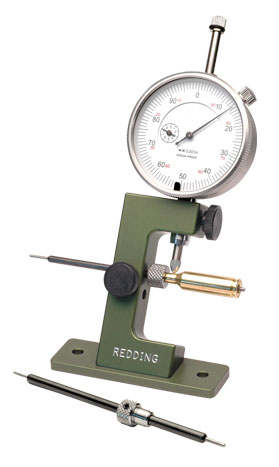Online Catalog
Case Neck Gauge
 Possibly one of the most important tools you will ever use!
Possibly one of the most important tools you will ever use!Provides a quick and easy way to sort cases by neck wall thickness and uniformity. This tool allows you to accurately measure the neck wall thickness of the cartridge case and determine its uniformity, (see below Tech - Talk – Case Neck Uniformity.)
Two mandrel sizes are supplied to allow measurement of all cases from .17 cal. to .338 cal. including cases with small (.060) flash holes. For your convenience the mounting base allows direct attachment to your reloading bench, or use the Redding No. 30520 double “C” clamp.
Pilot stops are required for each caliber. Two pilot stops are supplied with the tool, #06121, .22 cal. and #06130, .30 cal.
|
– Tech Talk –
Case Neck Uniformity Uniformity of case neck wall thickness is an indication of the quality of the cartridge case itself. Any large variation (over .0015”) in neck wall thickness will generally indicate a similar or greater variation in the body and shoulder of the case. This variation cannot be corrected and may lead to concentricity and bullet runout problems. Most competition shooters that have been forced to turn necks to properly fit “tight neck” chambers will confirm the following: “Turning the necks of poor quality cases will not solve the problems associated with the poor uniformity that remains within the shoulder and body of the case.” As in all handloading practices – uniformity is the key to accuracy. |




